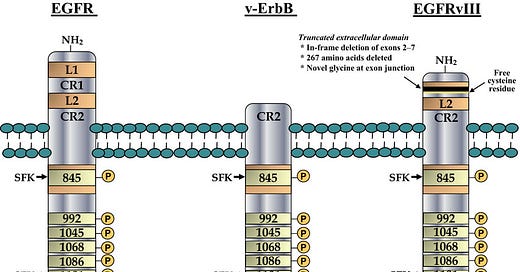The news emerged this week that Roche quietly removed the EGFRvIII x CD3 bi-specific T-cell engager (“BiTE”) antibody RG6156 from its development pipeline in 4Q2023. RG6156 was in Phase 1 clinical development for GBM (NCT05187624). The clinical program was based in part upon pre-clinical work that has been reported in the literature (see here).
Roche and its collaborators did not offer an explanation for removing the RG6156 program from the pipeline. As we outlined in Part 3a – Strategic Investor Perspective, there can be a multitude of reasons to stop a development program, and only some of them are scientific/clinical. With finite investment capital available even at the largest BioPharma companies, portfolio prioritization decisions have to made continuously. We hope that the clinical data gathered during the Phase 1 study will eventually be published.
EGFRvIII-targeted Approaches: Count Us Unimpressed
While EGFRvIII seems to be an obvious target in GBM based on its amplification relative to other non-neoplastic cells, we believe that the literature over the past 20 years (see here, here, here, here and now RG6156…and dozens more papers) has repeatedly demonstrated that EFGRvIII-targeted approaches have been unencumbered by success principally due to:
Highly dynamic and fungible ecDNA-driven mechanisms that rapidly deplete the EFGRvIII cell surface antigen under therapeutic pressure, resulting in a heterogeneous TME that is populated by tumor cells that do not display EGFRvIII; and
In the case of macromolecular therapeutic agents in particular, difficulty in transiting the BBB such that enough agent gets to the tumor with a dwell time sufficient to affect the desired pharmacodynamic action.
Perhaps, doing the same or a similar experiment over-and-over again while expecting a different result is not a reasonable strategy?
A more rational approach, if one wants to target EGVR (vIII or wt):
Make sure that the therapeutic agent can cross the BBB in a sufficient amount either (i) by engineering the medicinal chemistry of LMW agents (Kp,uu,brain anyone?); (ii) or by pairing HMW agents with a protein engineering, directed energy or drug delivery mechanism that enhances trans-BBB neuropharmacology; and
Combine the EGFR-targeted agent with brain-penetrant molecule that interdicts the ecDNA pathways.
Fun Fact: Unlike other non-brain cancers, there has yet to be a significant gain-of-function intracellular kinase domain variant catalogued for EGFR in GBM cells. Why is that the case? Maybe the ecDNA-resident sequences do not hang around long enough to develop intracellular kinase domain mutations? Hmmm.




